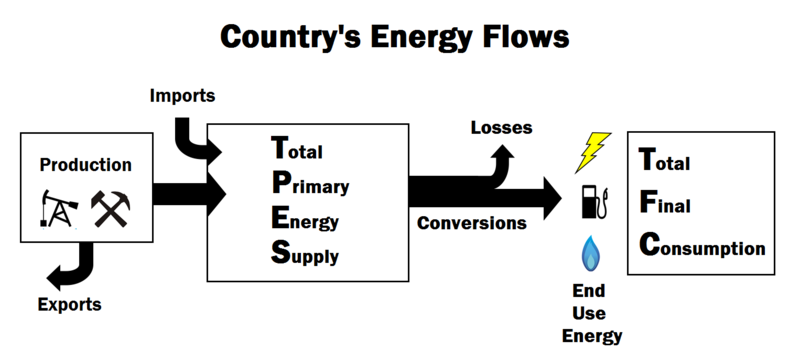End use energy
End use energy is the energy directly consumed by the user, as opposed to primary energy which is the energy that is harvested directly from natural resources. End use energy includes electricity, gasoline, and natural gas. Primary energy is usually in a form that is difficult for a consumer to extract, so energy conversion technology is used to change the form of the energy. When looking at energy use by sector, some organizations report end use energy and some report primary energy, for a detailed discussion please see primary vs end use accounting.
A country's complete profile of end use energy is often called total final consumption. This is usually a compilation of how much each of the following are used:
- Electricity - this is neither a primary fuel nor a primary flow, but an energy currency that is produced by power plants and transported through the electrical grid
- Gasoline - crude oil is a natural resource, but it must be turned into a secondary fuel like kerosene, diesel or gasoline to use as a secondary fuel in an engine.
- Natural gas - there is rarely a distinction made between the raw natural gas that's extracted from the ground and the consumer natural gas that's sold, although there are differences in chemical makeup.

Electricity
Electricity is the clearest example of how end use energy and primary energy differ. Primary energy is the energy that goes in to electricity production, while end use energy is the amount of electricity that we use. These are two very different numbers. A typical power plant runs at about 33% efficiency. This means that power plants consume three times as much energy in fuel (like coal) as the amount of energy produced as electricity.
Transportation
The distinction between primary energy and end use energy is more subtle with transportation fuels. The amount of energy available is fairly similar in both types because comparatively little energy is lost converting crude oil to transportation fuels, so transportation makes up a small portion of primary energy. In other words, gasoline, diesel and kerosene have roughly the same amount of chemical energy that the oil or bitumen would have as a primary fuel. Chemically, there are differences in the structure of the molecules for these secondary fuels vs. the original oil.
Interactive data visualization
The data visualization below shows the end use energy for different countries. Notice how different countries use more or less electricity, or oil products (like gasoline or diesel).
For Further Reading
- Electricity as an energy currency
- Hydrogen as an energy currency
- Transportation energy use
- Residential energy use
- Industrial energy use
- Primary energy
- Or explore a random page
References
- ↑ Created internally by a member of the Energy Education team.

